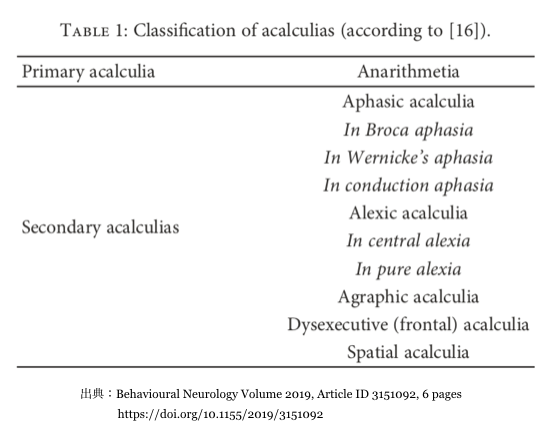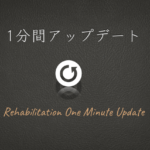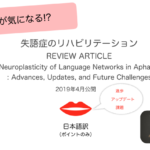【OT・ST – ポイント和訳】総説 – 後天性計算障害の認知リハビリテーション:【Review Article】Cognitive Rehabilitation of Acquired Calculation Disturbances
Review Article:Cognitive Rehabilitation of Acquired Calculation Disturbances(2019)の和訳について
脳血管障害領域で臨床をされている作業療法士・言語聴覚士の方の情報収集の利便性を考え
「 Review Article:Cognitive Rehabilitation of Acquired Calculation Disturbances 」
論文情報
:Behavioural Neurology
Volume 2019, Article ID 3151092, 6 pages | https://doi.org/10.1155/2019/3151092
Published 4 April 2019
を翻訳してみました。(アブストラクトと一部のみ翻訳)
リハビリ専門家をはじめ、計算障害のリハビリテーションに関心のある方が、英語論文を読み始めるきっかけになることがありましたら幸いです。
【日本語訳について】
このページの翻訳は、英語論文の著者によって作成されたものではありません。PT・OT・STニュース.blogによって日本語に翻訳されており、英語論文の著者はこの翻訳の内容や正確性について責任を負いません。尚、正確な記述に関しては出典の英語版をご確認ください。
出典:
Behavioural Neurologyのウェブサイト
https://doi.org/10.1155/2019/3151092
(Behavioural Neurology内の論文ページにリンクします)
2019年6月7日利用
PT・OT・STニュース.blogが翻訳した文章のライセンスは、クリエイティブ・コモンズ・ライセンス(CCライセンス):CC BYです。
総説 – 後天性計算障害の認知リハビリテーション
アブストラクト:Abstract
失算は、一般に左後部頭頂皮質(後頭頂皮質)損傷に関連する計算能力の後天性疾患です。
Acalculia is an acquired disorder in calculation abilities, usually associated with left posterior parietal damage.
通常、2つのタイプの失算に区別されます。
(1)数概念が喪失される、一次性失算または失演算
(暗算・筆算の両方で困難さがある)
* 補足説明:失語や視空間認知障害を伴わない失算
(2)認知障害の違いにより数学能力(数的能力)に影響を与える二次性失算
* 補足説明:各種高次脳機能障害(失語症・視空間認知障害・注意障害・全般的認知面低下など)に伴う失算。
Two types of acalculic disorders are usually distinguished:
(1) primary acalculia or anarithmetia, where the patient presents a loss of numerical concepts (difficulties are observed both in oral and written calculations),
and
(2) secondary acalculia due to a different disturbance in cognition and affecting mathematical abilities.
二次性失算は失語症・失読症・失書・遂行機能障害または視空間障害に関連します。
Secondary acalculias are associated with aphasia, alexia, agraphia, executive function disorders, or visuospatial difficulties.
この論文は、一次性失算・二次性失算に対するリハビリテーションの臨床的介入(治療法)の提案です。
This paper is a proposal for clinical intervention to rehabilitation of acquired primary and secondary acalculias.
表1.失算の分類(文献[16]による)
Table 1: Classification of acalculias (according to [16]).
*[16] A. Ardila and M. Rosselli, “Acalculia and dyscalculia,” Neuro- psychology Review, vol. 12, no. 4, pp. 179–231, 2002.
結論:Conclusions
後天性計算障害の認知リハビリテーションに関する情報は限られています。
しかしながら、いくつかの一般的な結論をまとめることができます。
The available information about the cognitive rehabilitation of acquired calculation disturbances is limited. However, some general conclusions can be drawn.
(1)一次性失算の基本的な治療目標は、数(の体系・概念)の理解を再構築することです。
一次性失算者は、数(の体系・概念)がどのように構成されているのかを理解していないようです。
(1) In primary acalculia, the fundamental therapeutic goal is to reconstruct the understanding of the numerical system. Patients with primary acalculia seemingly do not understand how the numerical system is organized
(2)失語症に伴う失算では、数の機能障害・回復と失語症の機能障害・回復が並行しています。
(2) In aphasic acalculia, numerical impairment and recovery in general parallelize aphasia impairment and recovery
(3)失算が視覚認知障害によるものである場合、基本的な治療目的は視覚認知を回復させることです。
(3) When acalculia is due to visuoperceptual disturbances, the fundamental aim of therapy is to recover visual perception
(4)前頭葉性の遂行機能障害による失算では、外的補助(例:文字)を活用したり、注意制御戦略(例:言語化)を活用することで、計算障害が改善される可能性があるかもしれません。
(4) In frontal dysexecutive acalculia, providing the patient with external support (e.g., writing) and attentional control strategies (e.g., verbalizing) may result in improving the numerical defect
(5)半側空間無視は、おそらくそれだけではないが、右半球損傷者に見られる筆算の計算障害の根本的な原因です。
読み始めを示すために明確なマークを使用するなどのシンプルな戦略で、計算障害をうまく改善することができます。
(5) Neglect represents probably not the only but the fundamental defect responsible for the written calculation defects observed in patients with right hemisphere damage. Some simple strategies, such as using clear marks to indicate where to begin to read, can successfully improve the calculation defects
これだけの翻訳でも、すでに高次脳機能障害者への認知リハビリテーションをされている臨床家の中には、おおよその支援方法について想像できる方もいるのではないかと思います。
後天性計算障害者へのリハビリテーションに関する文献は、原文でも述べられているように他の高次脳機能障害に比べ少ないように感じます。
原文では詳しい内容の説明がされていますので、後天性計算障害者のリハビリテーションに関心のある初学者の方は、英語学習や失算関連の文献探しを兼ねてチェックしてみてください。
原文:https://doi.org/10.1155/2019/3151092
(Behavioural Neurology内の論文ページにリンクします)





